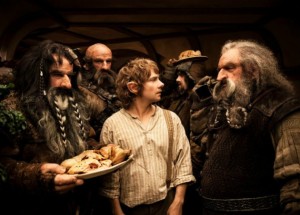The Hobbit: An Unexpected Journey
Posted on December 13, 2012 at 6:00 pm
B| Lowest Recommended Age: | Middle School |
| MPAA Rating: | Rated PG-13 for extended sequences of intense fantasy action violence, and frightening images |
| Profanity: | Some strong language |
| Alcohol/ Drugs: | Drinking, smoking |
| Violence/ Scariness: | Extended fantasy violence and peril with swords and arrows, characters injured and killed, scary monsters |
| Diversity Issues: | Diverse characters |
| Date Released to Theaters: | December 14, 2012 |
| Date Released to DVD: | November 4, 2013 |
| Amazon.com ASIN: | B00E8S2JZ4 |

As the second in the Hobbit trilogy is about to be released, The Hobbit: An Unexpected Journey (Extended Edition)
It does not help that Jackson himself seems to miss the forest of the story for the literal trees. Blowing out the shortest and most accessible of the books to a projected trilogy of nearly nine hours suggests that Jackson has fallen so in love with the project that he has lost touch with what it feels like not to be completely obsessed with it. Of course, he is enabled by the intensity of the fans, who are famously dedicated to every leaf, twig, and Elvish declension. But he seems to have lost track of the thread of the story and dulled his sense of how to communicate with those who are not as deeply involved with the story as he is. He glosses over the important discussion of Bilbo’s two competing heritages, one open to adventure, one devoted to home and hearth, which makes it hard to understand why he changes his mind about accepting Gandalf’s challenge. Since it is a prequel, we are all familiar with the destructive power of the One Ring to Rule Them All, which makes it confusing when we see it 60 years earlier as a simple and benign invisibility ring. Meanwhile, it takes all of 40 minutes before Bilbo leaves his house as what should have been a 10-minute scene about the unexpected arrival of a bunch of rowdy dwarves is expanded to include two different musical numbers. And yet, it still does not give us enough of a sense of who the individual dwarves are.
The action scenes are filled with vitality and dynamically staged, but the film assumes a commitment and understanding on our part that it has not earned. In a story about a quest of honor, that is an unexpected disappointment.
Parents should know that this film includes many battle sequences and scenes of peril, scary monsters, characters injured and killed, some disturbing images, smoking, drinking, and some potty humor.
Family discussion: Why did Bilbo decide to join the adventure? Why did Gandalf pick him? Why didn’t Gandalf use his powers to help the dwarves sooner?
If you like this, try: The book by J.R.R. Tolkien and the “Lord of the Rings” films

I give this one star out of four – what a disappointing dud. To say my expectations for something of the same quality as Lord of the Rings were dashed to bits is an understatement. Sure, the filming and 3D and 48FPS is great – but in the hands of a novice who doesn’t have a fraction of the skill with 3D as James Cameron (who invented it, after all…). The worst part is that Peter Jackson fabricated about 2/3 of the story, displacing much of Tolkiens story with his team’s own amateurish literary efforts, and thereby creating essentially a “made for TV” movie. A terribly disappointing movie – J.R.R. must be spinning in his grave. I wonder how long it will take his family to rescind rights….
Sorry you were disappointed, Keith. The additional material was not written by Jackson, though — it comes from Tolkien’s other writings about Middle Earth. But as you can see from my review, I agree that it was a mistake to add in that material. They should have stuck to the book.